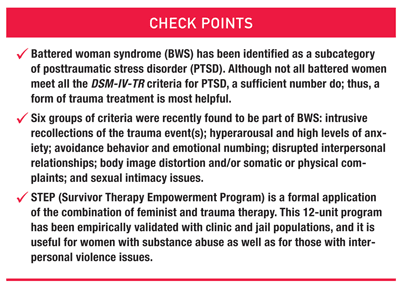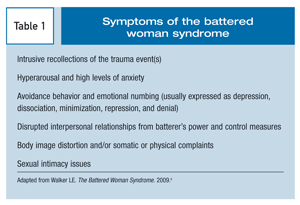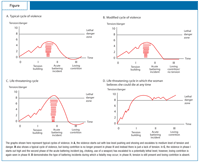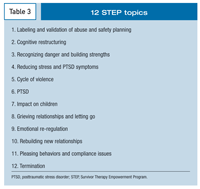Publication
Article
Psychiatric Times
Battered Woman Syndrome
Author(s):
Psychological symptoms develop in some women who are victims of physical, sexual, and psychological abuse, making it difficult for them to regain control.
Women who are victims of intimate-partner violence have been identified by the mental health field for more than 30 years now.1-3 It is understood that domestic violence is part of gender violence, and that many more women than men are the victims of physical, sexual, and psychological abuse.4-6 Even when women strike back or engage in mutual violence, it is usually the woman who is most likely to be hurt-both physically and emotionally. Women who strike back in self-defense are often arrested along with the batterer.
It is further understood that gender violence is fostered by the socialization of men to be more powerful than women. In some men, this process creates the need to abuse power and to control women.5 While the term “victim” is not always considered politically correct, in fact, until battered women take back some control over their lives, they may not truly be considered survivors.7 Psychological symptoms, called battered woman syndrome (BWS), develop in some women and make it difficult for them to regain control. Mental health professionals have been able to assist these battered women with empowerment techniques and with accurate diagnosis and proper treatment, as described here.

BATTERED WOMAN SYNDROME
BWS has been identified as a subcategory of posttraumatic stress disorder (PTSD).8 Although not all battered women meet all the DSM-IV-TR criteria for PTSD,9 a sufficient number do; thus, a form of trauma treatment is most helpful.10
Table 1 lists 6 groups of criteria that recently have been found to be part of BWS.8
DIAGNOSIS
A number of steps will help you obtain accurate information when you are interviewing a woman whom you believe may be abused by her intimate partner (Table 2).
Safety
Begin by speaking with the woman without her partner present (if they are still together) and together form a safety plan. This can be difficult because batterers often want to be present during the entire examination so they can directly or even subtly remind the woman not to disclose their secret. It is not uncommon to feel as if the man were in the interview-even if he is waiting outside.

For a woman in a battering relationship, the most dangerous time is when she and her partner are discussing or thinking about separation.11,12 Even if the woman is no longer living with the batterer, she may not be safe. It is important to help her feel safer by making it clear that you will not take advantage of her. The clinician can set up boundaries between himself or herself and the woman by asking her permission to touch her, to write notes, and to discuss areas of confidentiality and privilege. Individual or group therapy rather than couples therapy is recommended, at least initially.
Validation
A battered woman needs to feel validated when she describes the abuse. This can be done by emphasizing the positive things she did to protect herself and her children if they were involved. Tell her that no matter what she may have done or said, no one deserves to be abused. Be careful not to ask or even intimate that she might have done something to provoke the batterer. Such questions will not create the rapport that facilitates empowerment-nor do they create a safe space for the woman.

Most battered women have been told of their faults over and over by the batterer. They also have experienced his jealousy, overpossessiveness, and attempts to isolate them from significant friends or family. They may need education about the impact of abuse on their physical as well as mental health.13
Therapy should emphasize the woman’s strengths so that she trusts herself and others again. Naming her a battered woman with BWS may help her accept that she is not “crazy” (as the batterer predicted her doctor would find).
Risk and assessment
It is important to do a risk assessment while also completing a mental status examination. Some battered women have other disorders in addition to PTSD and BWS.7,8,13
To assess the risk of further abuse, ask the woman to describe the first abusive incident that she can remember, the worst or one of the worst episodes, the last abuse before she came to see you, and typical incidents. Such questioning usually elicits sufficient information to determine the level of lethality and risk that she faces. The patterns of violence depicted in the Figure can also be used to help you assess the level of danger.
TREATMENT
A plan
Negotiate a treatment plan with the woman. The Survivor Therapy Empowerment Program (STEP) has been used effectively with individual women as well as with groups (Table 3).8

It is important to assess the woman’s resilience in addition to the degree to which she reexperiences the abuse, her hypervigilance and arousal level, and her avoidance behaviors.14
Although gathering information about the woman’s childhood history is useful, it is probably not the first area to explore. While almost half of the women in our research sample of more than 400 battered women had experienced child abuse (usually sexual abuse by a father or stepfather), many of these women were not ready to discuss these traumatic experiences initially and often were more likely to reveal them as treatment progressed.8
In an earlier research project conducted by this author, women were asked about factors that made it more difficult for them to leave the abusive relationship.8 Mental illness and previous trauma were not specified by the women interviewed, although learned helplessness and drug abuse were factors that stood out as deterrents to finding safety from violence.

Women who have experienced multiple traumas may have relatively little resilience to deal with current trauma. This is an important clue to the psychotherapist to move slowly in the treatment plan, regardless of whether earlier trauma is discussed. Medication may be discussed with the woman when appropriate, but it is important for her to contribute to any decision so that she feels more in control of her life.
Most battered women respond to cognitive rather than affective techniques initially-although both areas eventually need to be part of the treatment plan. As cognitive clarity is developed, attention, concentration, and memory will be enhanced. A battered woman may be so anxious during the initial interview that she cannot remember much of what has been said. It can be helpful to provide her with a card that lists resources, such as the local shelter for battered women. Repetition of the areas discussed may be important, especially until the woman has regained attention and concentration.
It often helps to recommend that the woman engage in more and different types of activities with other people. Such activities can help her overcome some of the isolation and the power and control that the batterer holds over her. She needs to understand that she may still be in danger, even if her partner has completed a treatment program.15
OPTIONS FOR THERAPY
Treatment of PTSD and BWS includes a combination of feminist and trauma therapy.8,16 The feminist therapy contribution acknowledges that psychotherapy is a relationship in which the formal power resides with both the therapist and the client.16 Acknowledgment of the situational factors that can be beyond a woman’s control (eg, the lack of equality in society between men and women) helps her accept that she still can attempt to change those factors that she can control.
Legal action may contribute to a woman’s sense of empowerment-especially if she is able to use domestic violence statutes in criminal or civil court to obtain a restraining or protective order, to cause the batterer to be arrested, and to get him into a batterer’s intervention program. Filing for divorce is also a stressful legal action in family court. When the batterer has financial resources, suing him for a personal injury tort might also be an empowering action, although it is difficult to spend the time and attention often necessary to win such a case.
Trauma therapy helps a woman understand that she is not “crazy” and that she is not the only one dealing with the psychological symptoms that come from exposure to trauma. Without the use of trauma-specific therapy techniques, a woman may be unable to move past psychodynamic barriers that make it more difficult for her to deal with her situation. Thus, focusing on the external “trauma triggers” rather than her own internal issues will help heal BWS symptoms.
Briere and Scott10 have outlined the various steps that need to be followed during trauma therapy with abuse victims. Changing her part in the family system, even if it is dysfunctional, may be dangerous.
Trauma triggers that cause PTSD and BWS symptoms need to be identified and behavioral techniques need to be used to reduce their potency. Behavioral techniques that are useful during this phase include relaxation training, guided imagery, and successive approximation with high arousal incidents. These behavioral and cognitive-behavioral techniques may also help the woman develop cognitive clarity over time.
Some women benefit from a description of the autonomic nervous system that regulates many of PTSD symptoms.
Typical trauma triggers include the memory of the way the batterer’s face or eyes look when he begins his abuse, the curse words he shouts, a particular phrase he uses to demean or humiliate, or even the aftershave he uses or other odors he emits during the abuse. Startle responses and hypervigilance to cues of violence are the last symptoms of BWS to be extinguished. In many women, these cues or trauma triggers never totally go away. This sensitivity can interfere with new relationships. It is often necessary to help a new intimate partner develop patience and understanding to save the new relationship, provided that it is nonabusive. Despite the myth that women often go from one abusive relationship to another, data suggest that fewer than 10% of all battered women do so.8
The STEP is a formal application of the combination of feminist and trauma therapy.16 This 12-unit program has been empirically validated with clinic and jail populations, and it is useful for women with substance abuse as well as for those with interpersonal violence issues.8 When STEP is used in institutions, such as jails or substance abuse treatment centers, a shorter, adapted version of the 12 topics listed in Table 3 is generally used. In clinics and in private practice, each STEP unit may be developed over several sessions. When asked about their satisfaction level after each session, all of the women who participated in this program gave positive comments that were highly correlated with the reduction in their scores on the Beck Anxiety Inventory.
DVDs of feminist therapy with a domestic violence victim17,18 and of a model 2-year treatment of a battered woman19 are available from www.psychotherapy.net.
LEGAL ISSUES
Many battered women are involved in legal issues and need the attention of the psychotherapist to help them get through the stress and help them understand what they need to do and to help them provide information their attorney needs. The Federal Violence Against Women Act (US Congress, 2005) provides numerous legal remedies, including declaring abuse as a violation of a woman’s human rights with subsequent opportunity for a federal lawsuit under the civil rights statutes.
Litigation frequently involves child custody and access to children. Each state has its own laws regarding parental responsibility, but they all usually presume that it is in the best interests of the child(ren) to have equal access to both parents. Unfortunately, batterers often use the children to continue their control over their ex-wives, so that it is difficult, dangerous, and usually impossible to share parental responsibility. Nevertheless, the parent whom the family court judge considers most likely to facilitate a friendly relationship with the other parent is often given greater access to the children. Mothers who try to protect their children from fathers who lack good parenting skills or who are actually abusing the children20,21 are frequently seen as engaging in “hostile and aggressive parenting,” “parental alienation syndrome,” “psychological Munchausen by proxy,” or other similar nonempirically based disorders. They often lose custody and sometimes even all access to their children. (See http://www.Leadershipcouncil.org for more information on the danger to children after separation and divorce.)
Mothers who have lost their children frequently become depressed in addition to their trauma symptoms and are unable to fight the legal system without money or psychological energy to do so.22 Their children may end up physically, sexually, and psychologically abused by the batterer-regardless of whether he has custody, and especially if the children do not follow his orders.20
In rare cases, battered women will kill their abusive partners rather than be killed themselves. As cited by the Bureau of Justice Statistics, fewer than 1200 battered women kill their batterers, while over 4000 women are killed by the men who batter them.1,23,24 The most deadly time for a woman is when the batterer believes their relationship is over. Batterers often threaten to kill rather than to let their partner go.
It may be safer for the woman to live with the batterer than try to terminate the relationship-especially if she has children she needs to protect. This is counterintuitive and seems to contradict the need for battered women to leave an abusive relationship. However, court mandates may take away most of her ability to protect herself and her children by forcing shared parental responsibility and residential custody on them. Sometimes the batterer becomes even more enraged or decompensates without the woman and children in the same home with him and ends up killing her, their children, and himself. Newspapers and television usually report these cases, sometimes without the details about the history of abuse.
An explanation of the symptoms of BMS can help juries understand when a battered woman kills in self-defense; it helps to meet the legal burden that the woman had a reasonable perception of imminent (not immediate, but about to happen) danger. It is important to explain how the woman’s fear and desperation are triggered when a new battering incident is perceived as about to occur. It is helpful for forensic mental health evaluators to have copies of previous therapy records in which the woman’s comments about abuse and fear of the batterer are recorded.
CONCLUSIONS
BWS, a subcategory of PTSD, may develop in women who are victims of intimate-partner violence. Like other forms of PTSD, symptoms of BWS may resolve after the woman is safe and out of the abusive situation. However, many women need psychotherapy to help them regain control over their lives. Some women also need psychotropic medication.
BWS symptoms may reoccur even after recovery if a new stressor or trauma is experienced. Some women may be empowered by receiving a restraining order or by taking actions that lead to the arrest of the batterer. For other women, litigation-particularly contentious child custody cases-may exacerbate stress. Mental health professionals can help abused woman get through these stressful times by making sure that the risk of further abuse is as low as possible.
Fortunately, most battered women with BWS heal, raise their children, and go on to live productive lives once they are safe from the batterers’ abuse of power and control.5,8,10,13,17
References:
References
1. Bureau of Justice Statistics Selected Findings. Violence Between Intimates (NCJ-149259). Washington, DC: US Department of Justice; November 1994.
2. Brown LS. Subversive Dialogues: Theory in Feminist Therapy. New York: Basic Books; 1994.
3. Walker LE. The Battered Woman. New York: Harper & Row; 1979.
4. American Psychological Association Presidential Task Force on Violence and the Family. Violence and the Family. Washington, DC: American Psychological Association; 1996.
5. Goodman LA, Koss MP, Fitzgerald LF, et al. Male violence against women. Current research and future directions. Am Psychol. 1993;48:1054-1058.
6. Centers for Disease Control and Prevention. Costs of intimate partner violence against women in the US.Washington, DC: US Department of Health and Human Services; 2003. http://www.cdc.gov/ncipc/pub-res/ipv_cost/ipv.htm. Accessed May 19, 2009.
7. American Psychological Association. Final Report of APA Working Group on Investigation of Memories of Childhood Abuse. Washington, DC: American Psychological Association; 1996.
8. Walker LE. The Battered Woman Syndrome.3rd ed. New York: Springer Publishing Company; 2009.
9. American Psychiatric Association. Diagnostic and Statistical Manual of Mental Disorders. Fourth Edition, Text Revision (DSM-IV-TR). Washington, DC: American Psychiatric Association; 2000.
10. Briere JN, Scott C. Principles of Trauma Therapy: A Guide to Symptoms, Evaluation, and Treatment. Thousand Oaks, CA: Sage Publications, Inc; 2007.
11.Centers for Disease Control and Prevention. Behavioral risk factor surveillance system 2005 report; 2006. http://ftp.cdc.gov/pub/data/brfss/2005summarydataqualityreport.pdf. Accessed May 19, 2009.
12.Campbell JC, Webster D, Koziol-McLain J, et al. Risk factors for femicide in abusive relationships: results from a multisite case control study. Am J Public Health. 2003;93:1089-1097.
13. Centers for Disease Control and Prevention. Adverse health conditions and health risk behaviors associated with intimate partner violence-United States, 2005 [published correction appears in MMWR. 2008;57:237]. MMWR. 2008;57:113-117.
14. Charney DS, Deutch AY, Krystal JH, et al. Psychobiologic mechanisms of posttraumatic stress disorder. Arch Gen Psychiatry. 1993;50:295-305.
15. Babcock JC, Green CE, Robie C. Does batterers’ treatment work? A meta-analytic review of domestic violence treatment. Clin Psychol Rev.2004;23:1023-1053.
16. Walker LE. Abused Women and Survivor Therapy: A Practical Guide for the Psychotherapist. Washington, DC: American Psychological Association; 1994.
17. Browne A. Violence against women by male partners. Prevalence, outcomes, and policy implications. Am Psychol. 1993;48:1077-1087.
18. Walker LE. FeministTherapy: Psychotherapy With the Experts Series.Needham Heights, MA: Allyn &Bacon; 1998.
19. Walker LE. The Abused Woman: ASurvivor Therapy Approach. Assessment and Treatment of Psychological Disorders Video Series.http://www.psychotherapy.net/video/Abused_Woman. Accessed July 1, 2009.
20. Bancroft L, Silverman JG. The Batterer as a Parent: Addressing the Impact of Domestic Violence on Family Dynamics. Thousand Oaks, CA: Sage Publications, Inc; 2002.
21. Edleson JL. The overlap between child maltreatment and woman battering. Violence Against Women. 1999;5:134-154.
22. Clements CM, Sabourin CM, Spiby L. Dysphoria and hopelessness following battering: the role of perceived control, coping, and self-esteem. J Family Violence. 2004;19:25-36.
23. Bureau of Justice Statistics Special Report. Murder in Families (NCJ-143498). Washington, DC: US Department of Justice; 1994.
24. Bureau of Justice Statistics. Family Violence Statistics: Including Statistics on Strangers and Acquaintances. US Department of Justice. http://www.ojp.usdoj.gov/bjs/abstract/fvs.htm. Accessed May 19, 2009.
For More Information
• American Psychological Association Ad Hoc Committee on Legal and Ethical Issues in the Treatment of Interpersonal Violence. Potential Problems for Psychologists Working With the Area of Interpersonal Violence. Washington, DC: American Psychological Association; 1997.
• US Department of Justice. Violence Against Women Act (VAWA). 2005. http://www.ovw.usdoj.gov/regulations.htm.





